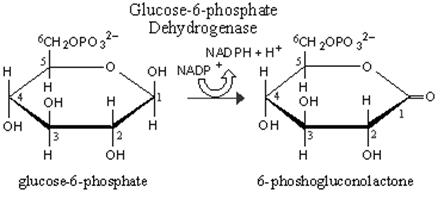PENTOSE PHOSPHATE PATHWAY
(HEXOSE MONOPHOSPHATE SHUNT)
Pentose phosphate pathway is an alternative way of glucose oxidation.
Its functions are:
- to supply to cells coenzyme NADPH, used as a hydrogen donor in biosynthetic reactions;
- to provide cells with pentose phosphates for the synthesis of nucleotides and nucleic acids.
Pentose phosphate pathway does not lead to the synthesis of ATP.
Pentose phosphate pathway of pentose formation occurs in the liver, adipose tissue, lactating mammary gland, tests, adrenal cortex, erythrocytes. The enzymes of pentose phosphate pathway are located in the cytosol.
In the pentose phosphate pathway of glucose conversion oxidative and non- oxidative pathways are released.
Oxidative phase includes two reactions of dehydrogenation. Coenzyme of dehydrogenase is NADP+. Pentoses are formed by oxidative decarboxylation.
1. Dehydrogenation of glucose-6-phosphate with the participation of glucose-6-phosphate dehydrogenase and coenzyme NADP+ gives 6-phosphoglucono-d-lactone and NADPH:

The 1st reaction is the most regulatory in the HMP shunt. NADPH is an inhibitor of glucose-6-phosphate dehydrogenase.
2. 6-Phosphogluconolactone is unstable and is hydrolyzed to 6-phosphogluconate under the action of 6-phosphoglucono lactonase:

3. Dehydrogenation and decarboxylation of 6-phosphogluconate to form ribulose-5-phosphate (pentose) and NADPH with the participation of decarboxylating 6-phospho-gluconate dehydrogenase:

4. Xyluloso-5-phosphate (pentose) is formed from ribulose-5-phosphate under the action of epimerase. Under the influence of ketoisomerase ribulose-5-phosphate is converted to ribose-5-phosphate (pentose). Between the forms of pentose phosphates equilibrium is established:

At this stage, the pentose phosphate pathway can be completed. Under anaerobic conditions, there a non-oxidative stageof pentose phosphate cycle comes. Non-oxidative stage includes reactions of transfer of 2 - and 3-carbon fragments from one molecule to another. The process is reversible, and hexoses can be formed from pentoses. Intermediates of glycolysis are formed (fructose-6-phosphate, fructose-1,6-bisphosphate, phosphotrioses), and substances that are specific to the pentose phosphate pathway (sedoheptulose-7-phosphate, pentose-5-phosphate, erythrose-4-phosphate).
Six molecules of glucose-6-phosphate in the pentose phosphate cycle form 6 molecules of ribulose-5-phosphate and 6 molecules of CO2. CO2 is formed from C-1 carbon atoms of six molecules of glucose-6-phosphate. Then 5 molecules of glucose-6-phosphate are regenerated by 6 molecules of ribulose-5-phosphate.
The overall equation:
6 Glucose 6-phosphate + 12 NADP+ + 7 H2O ®
® 5 Glucose 6-phosphate + 12 NADPH + 12H+ + 6 CO2
The intermediates of the cycle (fructose-6-phosphate and glyceraldehyde 3-phosphate) are included in glycolysis.
Gluconeogenesis
Gluconeogenesis is a glucose synthesis from substances of non-carbohydrate nature, which takes place mainly in the liver, and less intense - in the cortex of kidney and intestinal mucosa.
The function of gluconeogenesis is the maintenance of blood glucose during prolonged fasting and intense exercises. A constant supply of glucose as an energy source is particularly necessary for the nervous tissue and erythrocytes.
Gluconeogenesis substrates are pyruvic acid, lactic acid, glycerol, amino acids. Their inclusion in gluconeogenesis depends on the physiological state of the organism.
Most of the reactions of gluconeogenesis are the inverse of glycolysis. They are catalyzed by the same enzymes as the corresponding reactions of glycolysis.
Three reactions of glycolysis (hexokinase (1), phosphofructokinase (3), pyruvate kinase (10)) are irreversible, and during gluconeogenesis other enzymes operate on these stages.

Дата добавления: 2018-09-24; просмотров: 1045;
